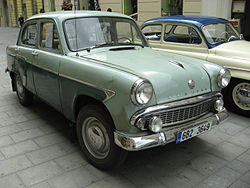- Moskvitch 402
-
Moskvitch 402/403/407 
Manufacturer MZMA Production 1956—1965 Predecessor Moskvitch 401 Successor Moskvitch 408 (for 402/407)
Moskvitch 412 (for 403)Class Small family car Body style 4-door sedan
5-door estate
3-door sedan deliveryLayout FR layout Engine 1.2L MZMA-402 I4 flathead engine, 35 hp (402)
1.3L OHV I4, 45 hp (34 kW)@4500 rpm, (403 and 407)Transmission 3-speed manual (1956-1960)
4-speed manual (1960-1965)Wheelbase 2,370 mm (93.3 in) Length 4,055 mm (159.6 in) Width 1,540 mm (60.6 in) Curb weight 910 kg (2,006 lb) Related Moskvitch 410 The Moskvitch 402 is a small family car manufactured by the former Soviet maker MZMA, first time introduced in 1956 as a second generation of the Moskvitch#Generations series. Unlike its predecessor, which was based on Opel Kadett's body, 402 featured many improvements such as four doors and a standard car radio.
Moskvitch 402 shared the same 4-cylinder flathead engine as its predecessors, however, whose construction dated back in the late 1930s of German engineering. The maximal speed that could be obtained on a free driveway was 88–90 km/h (54 mph), no more than a slight increase over the 401 series (and mostly due to considerable reductions in body weight). It was not until 1958 that the engine was replaced with MZMA's OHV development (among other changes to the motor) which allowed to obtain a maximal speed increase up to 115 km/h (70 mph) and a much less noisy drive. The new engine 402 model was manufactured as Moskvitch 407.
In 1961, the 407 model was further upgraded with an even stronger, faster M-407D1-D2 engine (allowing to handle the fourth speed on a manual transmission), self-adjusting brake cylinders and hydraulic clutch drive, alongside a completely restructured driver's interior panel. This model, manufactured as Moskvitch 403, served as a transition between the second and the third generation of Moskvitches, which debuted in 1964. The 402 model was completely discontinued by August 1959, with the 407 production ending in 1963 and the 403 in 1965.
Moskvitches 402 and 407 could be considered as the first step in USSR/Russia's automotive history towards producing customer-adapted trim levels for various uses. While the 407 model provided greater driving comfort at bigger expenses, other trims also included the 424 station wagon available for the general public, 431 delivery pick-up/ambulance van and even the 410/411 attempt of creating an SUV-based sedan/station wagon.
Trims and body styles
- Moskvitch 402 — the original series, produced from 1956 to 1958.
- Moskvitch 407 — same series with modified engine and frontal grille, produced from 1958 to 1964.
- Moskvitch 403 — improved version of 407, with notable interior accommodations. Produced from 1961 to 1965.
- Moskvitch 423 — second generation station wagon (after Moskvitch 422-422K), produced between 1957 and 1958.
- Moskvitch 423H — its upgraded version (407 engine featured), produced 1958 through 1963.
- Moskvitch 410 — first Soviet crossover, briefly produced between 1957 and 1958.
- Moskvitch 410H — an upgrade on the 410 model (similar to the 403 upgrade of 407) featuring, however, a lesser drivetrain. Produced 1961 through 1964.
- Moskvitch 411 — a station wagon crossover, produced between 1959 and 1961.
- Moskvitch 430 and 430H — both two-door delivery pick-ups, with H being its crossover variant. The H was never released, however, due to increasing production costs, while 430 itself was briefly manufactured in 1958.
- Moskvitch 424 — the 423 model redesigned to feature a convertible passengers/cargo rear compartment, possible unification of 423 and 430 models released from 1963 to 1965.
- Moskvitch 432 — delivery pick-up variant based on 403 model, produced and discontinued in 1964 in favor of Moskvitch 433.
- Moskvitch 407 coupe — short-lived 2-door sport variant of 407, produced in 1962.
Categories:- Moskvitch
- Sedans
- Station wagons
- Rear wheel drive vehicles
- Soviet automobiles
- 1950s automobiles
- 1960s automobiles
- Vehicles introduced in 1958
Wikimedia Foundation. 2010.
